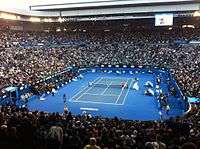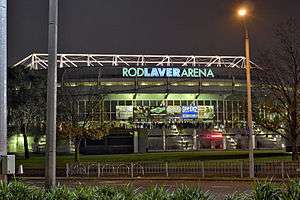Rod Laver Arena
Coordinates: 37°49′18″S 144°58′42″E / 37.82167°S 144.97833°E
| The Tennis Centre | |
|
| |
|
The venue at night, viewed from Batman Avenue in 2006 | |
| Full name | Rod Laver Arena at Melbourne Park |
|---|---|
| Former names |
National Tennis Centre at Flinders Park (1988–96) Centre Court (1996–2000) |
| Location |
Olympic Boulevard and Batman Avenue Melbourne VIC 3001 Australia |
| Owner | Melbourne and Olympic Parks Trust |
| Operator | Tennis Australia |
| Capacity |
14,820 (seated)[1] 15,400 (basketball / netball) 16,200 (concert) |
| Record attendance | 16,183 - Justin Timberlake, 18 November 2007 |
| Surface |
Plexicushion (tennis) Hardwood (basketball / netball) |
| Construction | |
| Broke ground | 1985 |
| Opened | 11 January 1988[2] |
| Renovated | 1995 |
| Construction cost |
$94 million (Original) ($230 million in 2016 dollars[3]) $23 million (1996 renovations) ($34 million in 2016 dollars[3]) |
| Architect | |
| Main contractors | Lendlease (formerly Civil & Civic) |
| Tenants | |
|
Australian Open (Tennis) (1988–present) Melbourne Tigers (NBL) (1992–2000) South East Melbourne Magic (NBL) (1992–98) Victoria Titans (NBL) (1998–2000) 2006 Commonwealth Games | |
| Website | |
| Venue Website | |
Rod Laver Arena is a multipurpose arena located in Melbourne, Victoria, Australia. Located within Melbourne Park, it is the main venue for the Australian Open in tennis since 1988, replacing the aging Kooyong Stadium. Construction began in 1985[4] and completed in 1987 at a cost of AU$94 million,[5] the arena opened on 11 January 1988 for the 1988 Australian Open.[6] The arena has seating capacity of 14,820 with a capacity of 15,400 for sports such as basketball (which includes extra seating around the court), and up to 16,200 for concerts with floor seating.[7] and currently attracts over 1.5 million visitors per year.
Originally known as the National Tennis Centre at Flinders Park[8] in 1988, the arena has officially changed name twice. First in 1996, when it was known as the Centre Court and again in January 2000 to honour Rod Laver, a three-time winner of the Australian Open and one of the world's greatest tennis players.[9]
Rod Laver Arena is the largest retractable roof arena in Australia (not counting the 56,347 seat Docklands Stadium which is also in Melbourne but is classed as a stadium rather than an arena) and is the second largest indoor arena in Australia behind the 21,000 capacity Sydney Super Dome.
Features and history

The arena features a retractable roof allowing competitors to continue play during rain or extreme heat. It is the centrepiece of the National Tennis Centre, and besides tennis, the arena hosts basketball, motorbike super-crosses, music concerts, conferences, World Wrestling Entertainment events (since 2003), and ballet. Other than for tennis, during sporting events or concerts, a section of the southern the lower seating bowl is retracted to allow space for a stage or special floor level seating.
Rod Laver Arena was the centrepiece of the 12th FINA World Aquatics Championships, which were held from 17 March-1 April 2007. A temporary swimming pool, named the Susie O'Neill Pool after Australian swimming champion Susie O'Neill, was built to allow this to happen.
The venue has hosted many professional wrestling events from WWE, World Championship Wrestling event in October 2000 and World Wrestling All-Stars and played host to the gymnastics competition in the 2006 Commonwealth Games.
Rod Laver Arena is equipped with the Hawk-Eye electronic system which allows tennis players to challenge the umpire's decision on calls made throughout championships.
On 3 April 1992, the arena became the home of Melbourne basketball when the Melbourne Tigers defeated the Canberra Cannons 112-104. The arena was also home to the South East Melbourne Magic (later renamed the Victoria Titans in 1998 after merging with the North Melbourne Giants) with both teams attracting some of the largest crowds in the history of the NBL. Rod Laver Arena was also the site of the first ever "outdoor" pro basketball game in Australia when the Magic hosted the Adelaide 36ers on 31 December 1997 with the roof open.
The largest basketball crowd at Rod Laver Arena was set in 1996 when 15,366 attended a local derby game between the Magic and Tigers. This remains the second largest basketball attendance ever in Australia behind the 17,803 who attended an NBL game between the Sydney Kings and West Sydney Razorbacks at the Sydney Super Dome in 1999. Game two of the 1996 NBL Grand Final series, also between the Magic and Tigers, saw the NBL's largest ever single game Grand Final crowd when 15,064 watched the Magic defeat the Tigers 88-84.[10]
1992 saw the first time two teams from the one city had reached the NBL Grand Final series when the Magic faced fellow Melbourne Park tenants the Tigers. With all games being played at the leagues largest venue a record aggregate of 43,605 (average 14,535) fans saw the Magic win their first championship two games to one, coming back to win games two and three 115-93 and 95-88 after losing game one 98-116.
In all, Rod Laver Arena hosted 287 NBL games including NBL Championship deciders in 1992, 1996, 1997 and 1999, and played host to its last game in April 2000 before Hisense Arena opened in 2000 and became the new home of Melbourne Basketball due to the continuing rising cost of staging games at the venue. The arena also hosted the Australian Boomers on numerous occasions, including playing against the Magic Johnson All-Stars in 1995, as well as hosting the 1997 FIBA Under-22 World Championship which Australia won for the first time.[11][12]
Rod Laver Arena's record attendance of 16,183 was set on 18 November 2007 for a Justin Timberlake concert during his FutureSex/LoveShow tour.[13]
In 2009, the arena polled 9th out of 50 worldwide top arenas for first-quarter ticket sales, making it the second highest ticket selling venue in Australia, second to Sydney's Acer Arena, which placed third. In 2012, the arena became Australia's highest selling venue and 4th in the world, based on 2011 ticket sales.[14]
American singer P!nk performed a record breaking 18 concerts at the venue in the winter of 2013 with her Truth About Love Tour, beating her own record of 17 shows from the Funhouse Tour in 2009.[15] She is currently the artist who holds the record for most shows at the venue.
In June 2015, it was announced that the arena would undergo a redevelopment of its exterior facade and interior customer features, such as bars and other facilities. Overall, more than $700 million is being spent on the multi-year redevelopment of the Melbourne Park precinct, which includes a new pedestrian bridge linking Melbourne Park and Birrarung Marr. Construction will begin in February 2016 though completion of all works at the precinct is not expected to finish until 2020.[16]
On 15 August 2015, Rod Laver Arena played host to the opening game of the 2015 FIBA Men's Oceania Basketball Championship between the Australian Boomers and the New Zealand Tall Blacks. In front of 15,062 fans Australia ran out 71–59 winners.[17]
Surface

From 1988 until 2007, the surface of the court in the arena was Rebound Ace, which was coloured green and known to favour serve and volley players. The surface was also blamed for many injuries in the Australian Open, with many players claiming that the surface became sticky in hot weather, making it difficult to play on.
In 2008, the surface was changed to Plexicushion, which is coloured blue. The surface is similar in properties to DecoTurf, the surface used in the US Open. This has more cushioning and more "give" than Rebound Ace. The change of surfaces gained a mostly positive reaction from players, as the surface is said to be easier to play on than Rebound Ace.
It has also had a temporary grass court in use, during the 1993 Davis Cup quarterfinals, 2001 Davis Cup final and the 2003 Davis Cup final.
Naming
- National Tennis Centre at Flinders Park (11 January 1988—28 January 1996)
- Centre Court (29 January 1996—15 January 2000)
- Rod Laver Arena (16 January 2000—Present)
Record Attendances
Concert
- 16,183 - Justin Timberlake, 18 November 2007
Basketball
- National Basketball League
- 15,366 - South East Melbourne Magic vs Melbourne Tigers, 22 June 1996
- International
- 15,062 - Australia vs New Zealand, 15 August 2015
Tennis
- 14,820 - Australian Open / Davis Cup (various)
See also
References
- ↑ http://www.austadiums.com/stadiums/stadiums.php?id=97
- ↑ http://www.worldofstadiums.com/oceania/australia/rod-laver-arena/
- 1 2 Australian Consumer Price Inflation figures follow the Long Term Linked Series provided in Australian Bureau of Statistics (2011) 6461.0 – Consumer Price Index: Concepts, Sources and Methods, 2011 as explained at §§3.10–3.11; this series comprises "from 1901 to 1914, the A Series Retail Price Index; from 1914 to 1946–47, the C Series Retail Price Index; from 1946-47 to 1948-49, a combination of the C Series Index, excluding rent, and the housing group of the CPI; and from 1948–49 onwards, the CPI." (3.10). Retrieved May 4, 2015
- ↑ "Tennis". Melbourne & Olympic Parks. Retrieved 2013-06-28.
- ↑ National Tennis Centre Trust and Zoological Board of Victoria (Report) (20 ed.). L.V. North. April 1993. p. 5. ISBN 0730634353.
- ↑ Colebatch, Tim (12 January 1988). "Melbourne's state-of-the-art tennis centre is a knockout". The Age. Melbourne, Australia. Retrieved 21 October 2013.
- ↑ Brandie, Lars (13 May 2013). "Pink's Australian Arena Tour Grows to 45 Shows". Billboard. Prometheus Global Media. Retrieved 19 May 2015.
- ↑ Sources for original venue name:
- Rabar, Julia (18 January 2013). "Looking back at the Australian Open from Kooyong to Melbourne Park". Herald Sun. The Herald and Weekly Times. Retrieved 19 May 2015.
- "25 Years of Retractable Roof Tennis in Australia". World Tennis Magazine. 10 January 2013. Retrieved 19 May 2013.
- Feinstein, John (1991). "The Finlders Park Jinx". Hard Courts: Real Life on the Professional Tennis Tours. New York City, New York: Villard Books. ISBN 9780307800961.
- Higdon, David (30 January 1994). "Women's Tennis Misses Seles As Graf Wins Again". Sun-Sentinel. Tribune Publishing. Retrieved 19 May 2015.
- Rowthron, Chris (September 2002). Landragin, Alex; Daly, Kate, eds. Victoria (4th ed.). Melbourne, Australia: Lonely Planet. p. 137. ISBN 1740592409.
- Beckley, Rachel (1 December 2012). "10Best: The History of Melbourne Park, Home of the Australian Open". USA Today. Gannett Company. Retrieved 19 May 2015.
- "How Peddle Thorp designed opening roof at Melbourne Tennis Centre". Peddle Thorp Architects. 3 February 2012. Retrieved 19 May 2015.
- ↑ "Centre court named after Laver". New Straits Times. Kuala Lumpur, Malaysia. 22 December 1999. p. 43. Retrieved 21 October 2013.
- ↑ Archived 29 August 2009 at the Wayback Machine.
- ↑ 1995 Australian Boomers vs Magic Johnson's All Stars - Melbourne
- ↑ 1997 FIBA Under-22 World Championship Semi-final
- ↑ Rod Laver Arena - Records & Performers
- ↑ "World's busiest arenas". PlaceNorthWest. 2012-01-25. Retrieved 2013-08-22.
- ↑ Brandle, Lars (2013-05-27). "Pink's Australia Tour Breaks Melbourne Venue Record". Billboard. Retrieved 2013-06-28.
- ↑ "Rod Laver Arena plans unveiled". SBS. 2 June 2015.
- ↑ 2015 FIBA Oceania Championship
External links
![]() Media related to Rod Laver Arena at Wikimedia Commons
Media related to Rod Laver Arena at Wikimedia Commons
- Official website
- Rod Laver Arena at Austadiums
- Peddle Thorp Melbourne
